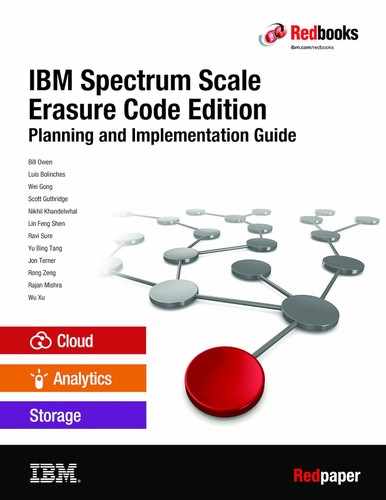

Summary
This paper describes the capabilities of IBM Spectrum Scale Erasure Code Edition. IBM is also researching future extensions and advances to IBM Spectrum Scale Erasure Code Edition. In this chapter, we also describe some possible new deployment models.
This chapter includes the following topics:
|
Note: Any references to future investigation are for planning purposes only. IBM reserves the right to change those plans at its discretion. Any reliance on such a disclosure is solely at your own risk. IBM makes no commitment to provide additional information in the future.
|
8.1 New Deployment Models
In this section, we discuss environments and technologies that might be supported in the future to allow ECE to support high-performance, scale-out storage in public and private clouds. We also discuss changes to our erasure coding technology for improved storage efficiency for high capacity workloads.
8.1.1 ECE on cloud
Running IBM Spectrum Scale on cloud resources can provide a high-performance and highly reliable file service for various workloads, such as AI, IoT, analytics, and general file storage. Some IBM Spectrum Scale advanced features, such as Active File Management (AFM) and Transparent Cloud Tiering (TCT), help customers to build hybrid cloud data solutions.
In general, cloud service providers provide volume storage services with high availability, such as AWS EBS volumes or Oracle Cloud block volumes. They also typically provide storage that is not replicated for durability.
ECE can be deployed on this infrastructure to build a high-performance, durable storage system that uses virtual block devices that are provided by public cloud service providers. Some cloud service providers, such as IBM Cloud™ or Oracle Cloud, can provide bare metal servers with disks that are attached locally. IBM Spectrum Scale ECE can run on these bare metal servers to build high-performance, reliable storage systems that are based on local attached disk within these servers.
Some IBM Spectrum Scale advanced features help customers to build a hybrid cloud storage system. For example, customers can use IBM Spectrum Scale Active File Management (AFM) to create an asynchronous data cache between traditional NFS or on-premises IBM Spectrum Scale cluster and an IBM Spectrum Scale cluster running in cloud.
IBM Spectrum Scale Transparent Cloud Tiering (TCT) can archive IBM Spectrum Scale data into Object Storage systems, such as AWS S3 or IBM COS. All of these advanced features work with ECE storage, regardless of whether the ECE cluster is deployed in your data center or in a public cloud.
IBM continues to advance ECE so that it is deployed and managed easily in various cloud provider environments. Today, ECE’s specific hardware requirements might not always match what is available in public cloud offerings. For example, different cloud service providers have different ways to export disk volumes to instances. Not all of these disk volumes can be recognized by ECE, particularly if the disk volumes do not show up as traditional SCSI or NVMe devices.
On public cloud, the mapping between virtual instances and physicals server is generally not exposed. Several instances in a Virtual Private Cloud (VPC) can be hosted by the same physical server. This ability means that a single node failure in a public cloud can cause several instances to fail at the same time, which can cause the ECE cluster I/O service to become unavailable.
Interfaces that allow cloud deployment infrastructure to control and monitor what physical resources are used for ECE virtual resources are needed to ensure that fault tolerance is provided as expected, or, at a minimum, is reported accurately.
8.1.2 Building a containerized ECE solution
In a deployment model that uses a Kubernetes-based container orchestration system to manage containerized applications and system resources (including storage), IBM Spectrum Scale ECE is one of the best considerations for software defined storage systems. ECE can provide storage services for persistent volumes running in OpenShift.
Recent OpenShift 4.x and related Kubernetes distributions recommend running all components in containers instead of deploying them in the host operating system. In this case, ECE also must be run in a container.
In the future, IBM Spectrum Scale ECE is planned to be generally available in a fully containerized mode.
At that time, significant benefits can be delivered in terms of deployment and management efficiency. Upgrades can be as simple as starting a new container image, cloud deployment, and bare metal deployment can become identical, and support for converged workloads becomes simpler because resources can be specified and managed on a container basis.
8.1.3 New erasure codes
Today, ECE supports 4+2P, 4+3P, 8+2P, and 8+3P erasure code protection types. ECE’s Reed-Solomon erasure code implementation can be extended to wider erasure codes; for example, 16+2P, 16+3P, 16+4P.
Wider erasure codes provide better storage capacity efficiency and tolerance for more concurrent faults. For example, 8+2P provides 80% usable storage capacity while 4+3P can provide only approximately 57% usable capacity. In the future, a 16+2P erasure code providers approximately 88% usable capacity. with a 16+4P erasure code, a system can withstand four concurrent failures and still maintain access to data.
In ECE systems, network bandwidth is used by the client workload and backend storage traffic between nodes. For read I/O, every 1.0 Gbps of usable bandwidth requires 2.0 Gbps of total bandwidth.
For write I/O, the overhead depends on the selected erasure code. When writing with 8+2P, each 1.0 Gbps of usable bandwidth requires 2.25 Gbps of total bandwidth. With 16+2P, the write bandwidth overhead factor is reduced to 2.125. Therefore, wider erasure codes with the same protection level also reduce the network bandwidth that is required for erasure code traffic.
However, tradeoffs exist. To use wider erasure codes, the recommended number of nodes in a recovery group is also increased. For example, at least 10 nodes are recommended in a recovery group to use 8+2P erasure code. If you plan to use 16+2P, at least 18 nodes are used in the recovery group.
Taking all of these factors into consideration, wider erasure codes are useful for workloads dealing large volumes of cool data that do not have extreme performance requirements.
8.2 Conclusion
In this IBM Redpaper publication, we introduced IBM Spectrum Scale Erasure Code Edition (ECE). ECE is a scalable, high-performance data and file management solution that is designed to run on any commodity server that meets the ECE minimum hardware requirements.
ECE provides all the functionality, reliability, scalability, and performance of IBM Spectrum Scale with the added benefit of network-dispersed IBM Spectrum Scale RAID. It provides data protection, storage efficiency, and the ability to manage storage in hyperscale environments that are composed of commodity hardware.
This technology provides all of the capabilities of enterprise storage controllers, running on hardware of your choice. With this capability, you can create high-performing storage systems for your most challenging workloads.
..................Content has been hidden....................
You can't read the all page of ebook, please click here login for view all page.
